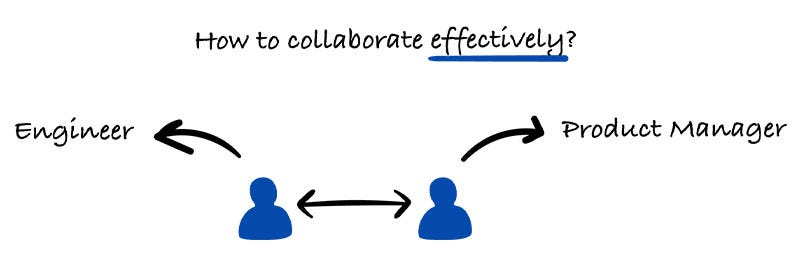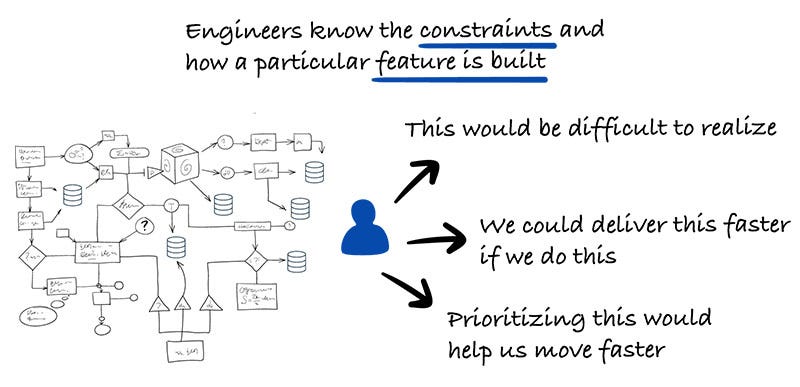How Can Engineers and PMs Collaborate Effectively?
Yue Zhao is sharing 3 key points for effective collaboration from her experience at Meta and Startups!
Intro
In any project that I am a part of, I make it my personal mission to find ways that engineering and product collaborate effectively. It’s really one of the most important things for business success long term.
I’ve been part of companies where product was finger-pointing at engineering for problems and the same went the other way as well → engineering finger-pointing at product.
And the overall success of the product was on a down-spiral because of that. So it’s really important to that we work well together.
Luckily for us, we have Yue Zhao with us today as a guest author. She is a Chief Product and Technology Officer turned Coach who helps women and minority leaders break through to the C-suite.
Yue spent 15+ years as a product executive in Silicon Valley. She was the Chief Product and Technology Officer at Fuzzy Pet Health, PM manager at Meta and Instagram, and first PM at Thumbtack.
She is also a fellow course instructor on Maven and writes a newsletter called The Uncommon Executive.
Yue will be sharing today 3 key points for effective collaboration between product and engineering.
This is our second collab with Yue and you can read our first collab here: CPTO: A role every company should consider? (paid article).
This is an article for paid subscribers, and here is the full index:
- 1. Effective collaboration between engineering and product management is crucial for business success
- It’s really important to involve engineers in strategy and discovery
- When engineers are not involved early, the product creation process lacks the engineer’s ability to add creativity and options to the discovery process.
- The ability for product management and engineering to stay in lockstep on strategy and execution remains essential at the higher levels
🔒 2. Do matchmaking based on strengths
🔒 Here’s what it sounds like to explicitly strategize about the makeup of the leaders on a team
🔒 A similar dynamic applies at the executive level as well
🔒 3. Treat your collaboration like a product
🔒 When I was at Thumbtack, we were growing quickly and new pods were constantly being formed
🔒 In addition, incorporate discussing expectations explicitly into your daily work together
🔒 Last words
Let’s get straight into it!
1. Effective collaboration between engineering and product management is crucial for business success
Effective collaboration between engineering and product management (PM) is one of the most critical drivers of business success for any technology-oriented company.
Friction between the teams can be seen in:
missed launch dates,
lower product quality or
frequency of escalations.
Most importantly, when teams are not set up to maximize the strengths of each function, we miss opportunities to delight customers and deliver outsized impact.
So how to ensure, that engineering and product collaborates effectively?
It’s really important to involve engineers in strategy and discovery
The number one cause for product launches that miss the mark on end-user impact is the lack of engineering involvement in the upfront discovery process.
From the CPO/CTO relationships to PM/EM/TL collaboration, engineering involvement upfront is critical to ensure the smooth delivery of impactful work.
In the discovery phase of a project, PMs naturally spend a large amount of time with researchers, data scientists, sales leads, and designers to uncover customer pain points and brainstorm potential solutions.
Meanwhile, engineers are often asked to focus on other build phase work and follow along through meeting notes (does anyone read those?). Some engineering leaders explicitly mandate their teams not to get involved until there is a “final design and product requirements document” under the guise of protecting their time.
This is a mistake.
In the best-performing teams at Meta and Instagram, PM and EM/TLs are in the discovery phase together, staying in sync each step of the way.
This is how I ensured to involve engineers early at Meta
When I was working on new 10X features for Instagram Feed, my TL, EM, and key staff engineers attended research interviews with me. While I handled 4-5 conversations a day, they took on 1-2 and sometimes, I would call them to attend “the good ones” in real-time.
We would also debrief together at the end of each day to see what we took away from the conversations. This debrief was especially valuable at the beginning of the process, as we discussed our observations, honed in on key hypotheses, and narrowed in on what further questions we wanted to ask.
Later sessions were more validation of existing ideas, and consequently less critical for the engineering partners. Meanwhile, I would keep a loose draft of a product requirement doc, mainly focused on summarizing our goals, constraints, hypotheses, and learnings.
Our designers would create or update prototypes based on learnings, so every 2-3 days we had a new idea to discuss with our target users. This iterative process allowed us to stay in lockstep on what we were trying to build and why, backed by real-time research conversations.
When engineers are not involved early, the product creation process lacks the engineer’s ability to add creativity and options to the discovery process
Engineers are most familiar with how a particular feature is built and why some seemingly simple idea may be difficult to realize.
They may see new ways of solving a problem from an architectural standpoint that the PM or designer may miss staying at the UX levels. This input is critical for prioritization in the discovery phase and remains essential throughout the build as unexpected challenges arise (as they always do).
When engineers miss out on the discovery phase of the project, they are building “blind”. Without opportunities to learn the nuances of customer problems and be a part of prioritization discussions, engineers lack sufficient knowledge of the why and how it’ll get used.
Instead, they follow a set of designs without thinking deeply about what the product is intended to accomplish, getting attached to the specific solution rather than the problem to be solved.
This leads to finger-pointing whenever new requirements or unexpected complications arise → “This wasn’t a part of the requirements” or “The design is final so we can’t change it”.
Ultimately, either a lower quality product is launched on time that misses the mark on delivering impact, or the entire development process slows down.
The ability for product management and engineering to stay in lockstep on strategy and execution remains essential at the higher levels
I’ve seen it too many a time where the CEO and CPO are discussing a new area of investment that requires certain architecture changes while the CTO is concurrently making architectural decisions that make those changes harder to achieve.
The mismatch also lessens their power to jointly lead company priorities. When they provide a united front, advocating together for the most promising ideas, they are more likely to get buy-in from the CEO, Sales, and Finance.
When I was at Fuzzy as CPTO, I truly missed having a strong CTO partner at times to help me pound the table for new ideas.





